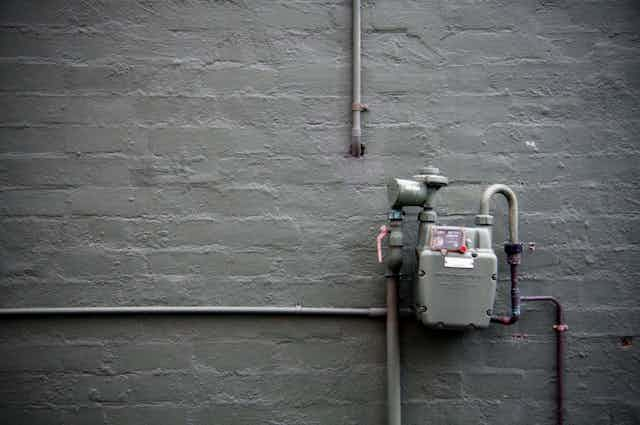A few years ago, similar to views about future electricity demand, forecasters thought gas demand in Australia would keep rising. As it turns out, gas demand peaked in 2012 and may halve by 2025 - as we showed in our recently published University of Melbourne Energy Institute (MEI) report, and earlier on The Conversation.
Step by step, householders are making economic decisions that will eventually lead to many completely disconnecting from the gas grid, as they find gas to be an increasingly costly secondary source of home energy.
This is particularly true when it comes to space-heating. When the cost of operating a modern reverse cycle air conditioner (known in Tasmania and elsewhere around the world as a heat pump) can be one-third the cost of heating with gas, why wouldn’t a householder have a look at the possibilities?
Another attraction is that heating with a reverse cycle air conditioner is largely renewable. Our research has quantified that reverse cycle air conditioners in Australia recover more renewable energy than do all of the millions of rooftop solar photovoltaic (PV) installations. Who knew?
Gas demand declining
The following chart illustrates how gas demand will decline in eastern Australia in all sectors: in the electricity generation sector, in industry and also in buildings as householders and building managers switch to efficient electric heating devices.

Previously we qualitatively described how in this “second electrification” of the Australian home, people will economically fuel-switch to induction cooktops, hot water heat pumps and reverse cycle air conditioners, resulting in their homes becoming gas-free.
As shown in the following chart, the money that householders can save when economically fuel-switching from gas to electricity can amount to hundreds and even over a thousand dollars per year.

Some of this change will occur very rapidly. In up to one million homes in eastern Australia, householders have already installed reverse cycle air conditioners for summer cooling but have never attempted to use them for heating. Why not? Time and time again I have been told by friends, acquaintances and those writing on social media, “Oh, I have always thought that gas must be cheaper.”
As shown in the following chart, analysis done by the Alternative Technology Association (ATA) indicates that using reverse cycle air conditioners to heat a large Melbourne home can amount to A$658 per year. But how is this possible?

Heat pumps: global renewable energy giants
The biggest reason behind these new home economics is that reverse cycle air conditioners produce far more energy than they consume. Operating at efficiencies of up to 600%, they use a small amount of purchased electricity to capture free renewable heat from the outside air. For ducted gas heating, which can operate at efficiencies of less than 50%, the opposite is true.
The following diagram shows that a ducted gas system will consume 34.02 megajoules of energy (including gas and electricity for the air blower: the sum of the two blue figures on the left) in order to produce just 10 megajoules of useful delivered heat. The rest of the gas energy purchased is immediately, in a sense, thrown away.

This compares to an efficient reverse cycle air conditioner that requires only 2.55 megajoules of purchased electricity (the sum of the blue figures on the right) to extract an additional 9.53 megajoules of free, renewable, ambient heat from the air outside your house, and then produce the same 10 megajoules of useful delivered heat.
In other words, in this comparison, in order to get the same amount of heat from a reverse cycle air conditioner, the householder must purchase only 1/13th of the energy needed to operate ducted gas. This efficiency advantage wipes out the traditionally lower cost of gas energy versus electrical energy when those commodities are compared on a dollar-per-megajoule or per-kilowatt-hour basis.
In 2014, reverse cycle air conditioners were such significant harvesters of renewable energy in Australia that our research found they recovered twice as much renewable energy as did rooftop solar photovoltaic (PV). The following chart compares these 2014 figures and also shows the future potential of reverse cycle air conditioners as more people learn of their capabilities.

In the United Kingdom, the renewable-energy-harvesting power of reverse cycle air conditioners is recognised and they are even eligible for renewable energy certificates in that jurisdiction.
In Australia, where governments have not been interested in rewarding people for buying air conditioners, no similar scheme exists. However, in an application of the same technology, hot water heat pumps do receive renewable energy credits here.
Gas stays in the ground – for longer
One consequence of falling gas demand in eastern Australia is that it will take longer to deplete already-developed conventional gas resources. As shown in the following figure, the Australian Energy Market Operator’s recent gas demand forecast results in the depletion of 10,000 petajoules of gas by 2032. In the Melbourne Energy Institute scenario (also plotted below), which projects that less gas is used in buildings, the same volume of gas lasts for more than an extra decade.

Using less gas in buildings, thanks to economic fuel-switching, energy efficiency measures (such as insulation, draught-proofing and improved window treatments) and other factors, means that a significant volume of gas can be freed up for higher-value industrial uses, as illustrated in the following chart.

Plenty of people in Australia are talking about disconnecting from the electricity grid. However, the costs and technicalities of battery storage and the possibility of needing to resort to a back-up petrol generator will convince many to stay connected to that often-reliable electricity grid.
On the other hand, we’ve shown the gas network is different. Households are making, and will continue to make, economics-based decisions to reduce gas use.
When planning the future of our energy grids, we think it is time that energy planners move away from decades of focusing strictly on supply-side options, and now consider gas and electricity demand-management options as well.

